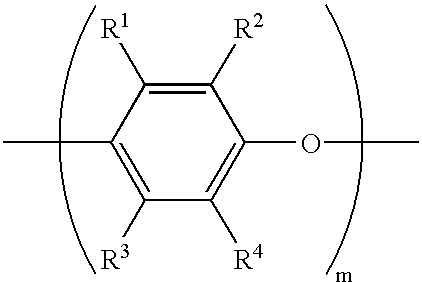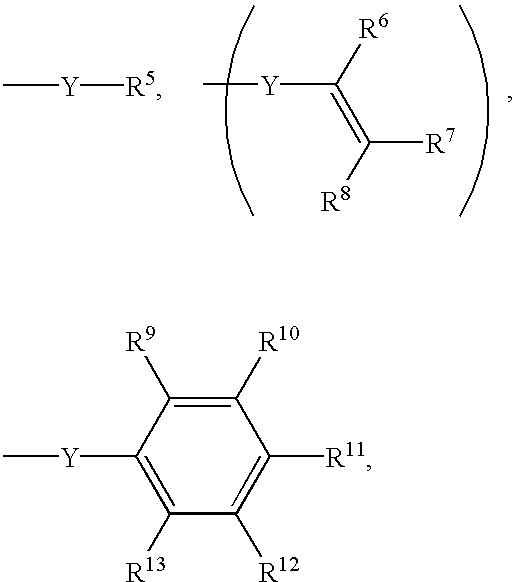Thermoset composition, method, and article
a technology of composition and thermoset, applied in the field of curable composition, can solve the problems of ineffective poly (arylene ether)-containing compositions, drop in viscosity, and poor glass carry of molded thermoset compositions,
- Summary
- Abstract
- Description
- Claims
- Application Information
AI Technical Summary
Benefits of technology
Problems solved by technology
Method used
Image
Examples
examples 25-30
[0159] Six samples were prepared varying in crosslinker amount, and polymeric additive and amount. The base resin for all samples was a 50 weight percent solution in styrene of a methacrylate-capped poly(2,6-dimethyl-1,4-phenylene ether) having an intrinsic viscosity of 0.12 dL / g.
[0160] The crosslinker was trimethylolpropane triacrylate (TMPTA) or trimethylolpropane trimethacrylate (TMPTMA). The initiator was t-butyl peroxy-2-ethylhexanoate, obtained as LUPEROX.RTM. 26 from Atofina Chemicals.
[0161] Three different polymeric additives were used. The additive designated "PEB Kraton L1203" in Table 3 was a monohydroxy-terminated poly(ethylene-butylene) having a hydroxyl equivalent molecular weight of 4,200 AMU, an approximate hydroxyl functionality of 0.9, and a specific gravity of 0.88 g / cc, obtained as KRATON Li 203 from Kraton Polymers. "PB Lithene N4-9000" was a liquid polybutadiene having a number average molecular weight of 9,000, 10-20% 1,2 vinyl microstructure, 50-60% trans-1,4...
examples 38-55
[0170] Eighteen samples were prepared varying in the type and amount of crosslinker, the type and amount of polymeric additive, the type and amount of initiator, and the molding temperature.
[0171] The base resin for all examples was a methacrylate-capped poly(2,6-dimethyl-1,4-phenylene ether) having an intrinsic viscosity of 0.12 dL / g. It was used in the form of a 50 weight percent solution in styrene. The initiator t-butyl peroxy-2-ethylhexanoate was obtained as LUPEROX.RTM. 26 from Atofina Chemicals. The initiator t-butyl perbenzoate was obtained as LUPEROX.RTM. P from Atofina Chemicals. The crosslinker was either trimethylolpropane triacrylate (TMPTA) or trimethylolpropane trimethacrylate (TMPTMA).
[0172] Five different polymeric additives were employed. A dihydroxy-terminated poly (ethylene-butylene) having a weight average molecular weight of 1,700 AMU was obtained as KRATON.RTM. L2203 from Kraton Polymers. A monohydroxy-terminated poly (ethylene-butylene) having a weight averag...
examples 74 to 79
[0189] Six compositions varying in poly(vinyl ester) type were prepared. Each sample contained 80 parts by weight of at 35% solution in styrene of methacrylate-capped poly(2,6-dimethyl-1,4-phenylene ether) having an intrinsic viscosity of 0.12 dL / g, 20 parts by weight of trimethylolpropane trimethacrylate, 10 parts by weight of the poly (vinyl alkanoate), and 2 parts by weight of t-butylperoxybenzoate initiator. The poly (vinyl esters)s were poly(vinyl propionate), poly(vinyl pivalate), poly(vinyl nonanate), poly(vinyl butyrate), poly(vinyl neodecanoate), and poly(vinyl neononanate). The blends were prepared by mixing the capped-PPE, the poly(vinyl ester), and the trimethylolpropane trimethacrylate at about 50-80.degree. C. The resulting solutions were cooled to about 40-60.degree. C. before addition of the initiator. The compositions were cured at 150.degree. C. All blends showed phase separation as indicated by the opaque white appearance of the cured discs. This opaque appearance...
PUM
| Property | Measurement | Unit |
|---|---|---|
| molecular weight | aaaaa | aaaaa |
| sol-gel transition temperature | aaaaa | aaaaa |
| sol-gel transition temperature | aaaaa | aaaaa |
Abstract
Description
Claims
Application Information
 Login to View More
Login to View More - R&D
- Intellectual Property
- Life Sciences
- Materials
- Tech Scout
- Unparalleled Data Quality
- Higher Quality Content
- 60% Fewer Hallucinations
Browse by: Latest US Patents, China's latest patents, Technical Efficacy Thesaurus, Application Domain, Technology Topic, Popular Technical Reports.
© 2025 PatSnap. All rights reserved.Legal|Privacy policy|Modern Slavery Act Transparency Statement|Sitemap|About US| Contact US: help@patsnap.com



